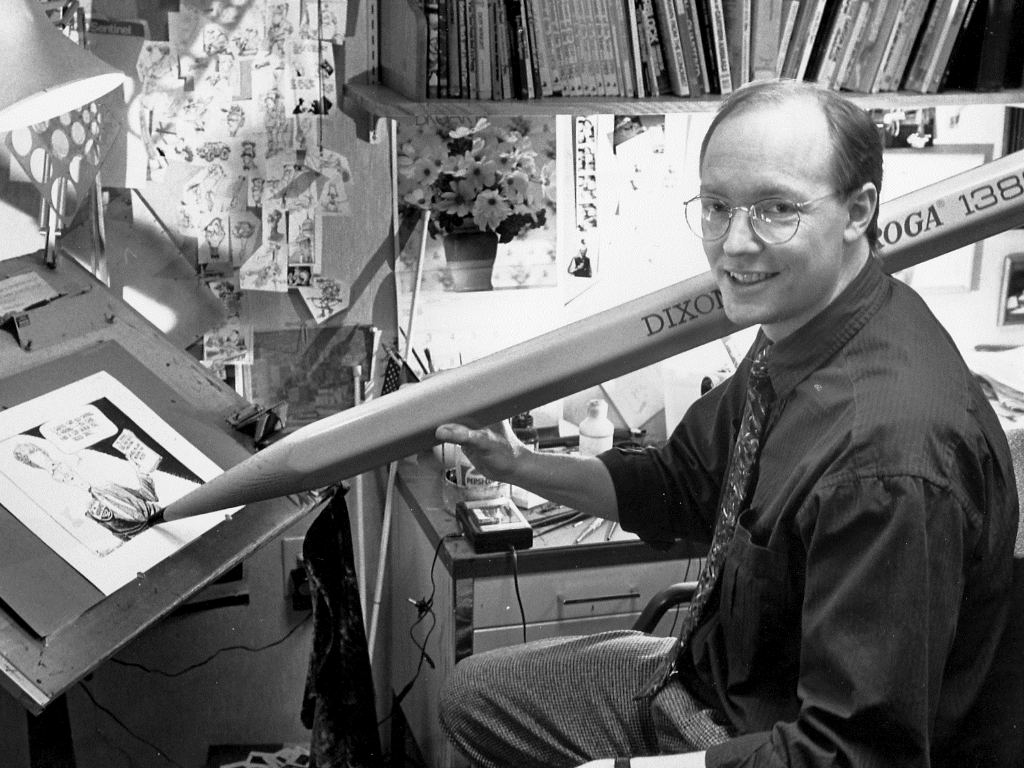Remembering Stuart Carlson
One of the great editorial cartoonists, who became too controversial for Journal Sentinel, dies at age 66.
Stuart Carlson could be funny about anything, including himself.
In 2008, when he was let go by the Milwaukee Journal Sentinel after 25 years with the paper and one of its two forerunners, the Milwaukee Sentinel, he told Milwaukee Magazine’s “Pressroom” columnist Erik Gunn how it happened:
“I voluntarily took the buyout, but voluntarily as when somebody puts a gun to your head and says ‘Hand over your wallet,’” he said.
I was the magazine’s editor then and asked Carlson if he wanted to do a cartoon to illustrate our column about his departure and he did a great one, of an earnest, unsuspecting editorial cartoonist being harpooned by a giant Number 2 pencil.
The JS did an obituary today celebrating the “fearless” cartoonist, while glossing over the reasons for his departure from the paper. The newspaper told him it could no longer afford a full-time political cartoonist, but this was also about re-positioning the paper politically, as Gunn reported. Carlson and editorial writer Jerry Resler, a fellow liberal, and both members of the newspaper’s editorial board, were let go that year, which shifted the board to the right.
“I wasn’t coming from a conservative, right-wing perspective,” Carlson later told Urban Milwaukee in a 2014 profile, “and I think that’s the demographic a lot of papers want to appeal to because that’s where the readership is growing.”
Milwaukee Magazine got a small sample of the blowback the Journal Sentinel was probably getting after I ran a couple cartoons by Carlson on a year-in-review feature we ran. I got emails and snail mail from readers objecting and threatening to cancel their subscription. The dilemma for the magazine was its readers came from a four-county area, most of them from outside Milwaukee County, and the ever-widening partisan gulf between Republicans and Democrats made editorial cartoons a particularly tricky proposition.
And yet there was a time, in the days of print-only journalism, that editorial cartoonists sometimes clashed with their own paper’s editorial view, and Carlson personified that duality. In 1983, he replaced the Milwaukee Sentinel’s former cartoonist, Tom Curtis, whose conservative views were in line with the paper, but whose cartoons were pretty dull. In short, the paper chose the far more talented Carlson even though he was a liberal.
Keith Spore, a former Sentinel editor who ran those cartoons for years, called Carlson “the best to ever create a political cartoon in Wisconsin” in the JS obit, adding “And he did so with absolute faith in the righteousness of his opinion regardless of who disagreed (including his editors).”
Which is to say Spore often disagreed with him.
Meanwhile the Milwaukee Journal was running the cartoons of Gary Markstein, who had more centrist views. After the two papers merged in 1995, the JS ran both cartoonists for four years and then dropped Markstein, reassigning him to designing features. In truth Markstein was a better fit for a paper trying to hug the center, but Carlson was clearly more talented.
In 1991, Carlson was named the nation’s best cartoonist by the National Press Foundation. In 1995, he won the prestigious John Fischetti Editorial Cartoon Award. And for years he also did four nationally oriented cartoons a week for the Universal Press Syndicate and after the JS let him go he was still doing this for UPS which ran his cartoons in 30 newspapers. But over time the number of those papers began to decline.
The decline of the editorial cartoonists began more than a century ago, as the number of newspapers began to decrease. As Politico reported in 2019, “At the beginning of the the last century, about 2,000 editorial cartoonists worked for American newspapers. By 1957 the number of full-time newspaper cartoonists had fallen to 275. As recently as 2007, they numbered 84, but the decline has continued to the point that the number of salaried cartoonists has reached about 30.”
“When I left [the JS] in 2008 that pretty much ended the long history that newspapers had of having on-staff political cartoonists. At the Journal Sentinel that tradition went back to the 1930’s,” Carlson told Urban Milwaukee.
As news coverage moved to the internet, editorial cartoonists were becoming dinosaurs. You had to pay for a print publication to see the cartoonist you loved, but editorial cartoons were shared and sent across the worldwide web with no money for their creator.
“Your stuff could be shared and go viral and you might never know or be credited,” Carlson told Urban Milwaukee. “Do I get residuals from that? No.” he says. “I just get the warm, squishy feeling of knowing that I’ll be hit by a bus someday and be dead and my stuff will still be circulating on social media.”
The interesting thing is that in person Carlson was a mild-mannered, kind man, who became skewer-sharp and funny as hell when creating his cartoons. That unique voice will be missed.
Murphy's Law
-
Top Health Care Exec Paid $25.7 Million
 Dec 16th, 2025 by Bruce Murphy
Dec 16th, 2025 by Bruce Murphy
-
Milwaukee Mayor’s Power in Decline?
 Dec 10th, 2025 by Bruce Murphy
Dec 10th, 2025 by Bruce Murphy
-
Total Cost of Foxconn Is Rising
 Dec 8th, 2025 by Bruce Murphy
Dec 8th, 2025 by Bruce Murphy





















I agreed with every Stuart Carlson editorial cartoon and every Stuart Carlson point of view… Why can’t we have a President who believes in the same things that Stuart Carlson believed in?
Thank you, Stuart Carlson, for holding the corrupt ruling class in this good for nothing country accountable for so many years… you’re departure leaves a hole in our hearts.
P.S. Now there are only two reasons to buy the Milwaukee Journal… #1 wrapping dead fish guts… #2 lining the bottom of your bird cage.
Don’t forget the BIG! BOOM! cartoony-ness of the artwork! His exuberant retro quality ran parallel to restrained “arty” style of others. Crazy, exaggerated, so damn much fun to look at. Certainly others offer brilliant concepts, but many produce visual op-ed haikus: elegant, minimal. Stuart Carlson did editorial CARTOONS! Big, brawling drawing that we’ll never see again.
Before Carlson’s time, but I remember Papa sitting with the inch-thick afternoon Journal. Khaki-collar Pabst worker, but he knew what was going on in the city, nation and world, via reporting from a free press. Yup, I’m gettin’ old.
I’m so grateful to have had the chance to meet Jerry Resler and Stuart Carlson at the start of my very brief journalism career. Jerry retired in the window when I worked as a Journal Sentinel intern, and a couple of years later I got the chance to hang out with the two of them when we three and ace cops reporter Linda Space were volunteering together in an MPS school to help fifth graders publish a student newspaper. I knew I was lucky then, but my appreciation has only deepened since. Thanks to Jerry and Stuart both for their incredible work, and for giving a 22-year-old kid the time of day.